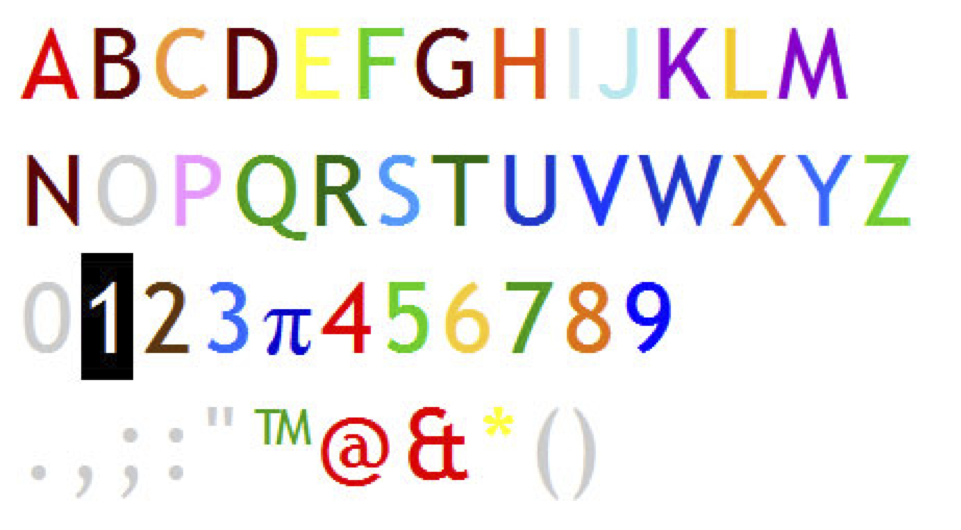The SFU Czech-English
Synaesthesia Project
Research Group Members:
Kathleen Akins (PI); Marcus Watson (UBC), Jan Chromy (Charles University Prague), Lyle Crawford (SFU), Nicole Pernat (SFU), Chris Spiker (SFU), Martin Hahn (SFU).
OVERVIEW
On the standard definition, synaesthesia is an condition in which people make 'unusual associations' between various 'sensations'. For example, a colour-grapheme synaesthete sees/thinks of letters (written in black typeface) as having particular colours—e.g. “A” is fire engine red and "B" is a Royal Blue. Similarly, people may associate particular colours with musicial notes or certain position in space with a month or a day of the weekk. Although it is now widely agreed that synaesthesia is a genuinely perceptual phenomenon, it is still not clear how or why certain people become synaesthetes.
In our research, we are interested in the role of learning in synaesthesia. We now know that synaesthesia runs in families and that there is a genetic component to synaesthesia. However, many—or most—synaesthetic associations involve cultural artifacts — letters, numbers, the names of the days of the week, muscial notes, and so on. So we can be reasonably certain that synaesthetes do not come into the world with such associations in place, even if some people are more likely, from birth, to develop some form of synaesthesia or other. In other words, we know that there is a learning component in synaesthesia but we do not know the precise role of learning.
Moreover, we also know that multi-modal representations are not 'unusual' in the brain, and they are not even that unusual as everyday experiences. For example:

Good news, everyone!!
(And whose voice did you just hear?)
If you're like me, you can't read that phrase and look at the picture without hearing the voice of Farnsworth. In fact, I can't listen to anyone say this phrase without 'hearing' the voice of Farnsworth 'in addition' to the voice of the person who is speaking. Similarly, how do you feel when you watch a person accidentally poke themselves in the eye (or close a door on a finger, etc.)? You feel a pian in the eye (or in the finger, etc.) Technically, these are forms of synaesthesia, word-voice, synaesthesia and visual-tactile synaesthesia. Yet these are very common conscious experiences of multimodal processing. So there may be multimodal mechanisms, already in place, that could be 'borrowed' for arbitrary learning tasks, such as learning to read.
Our research group is looking at this problem of multimodal learning with a survey, and follow-up experiments, of two different populations, native Czech and Englisch speakers. Czech and English use alphabets that are very much the same. However, unlike in English, every letter (grapheme) in Czech is associated with exactly one sound/phoneme, what is called an orthographically transparent language. In contrast, English is a notoriously opaque language. Most letters can be pronounced in more than one way depending upon the context (e.g. Catch) English vowels are particularily difficult to learn for this reason: Depending upon the precise dialect, English may have upwards of eight different phonemes associated with a vowel (think of saying “but”, “rude” and “upon”).
This difference between the languages has many consequences for how children learn to read—and the methods used to teach reading—in each language. For example, English speakers find it very surprising that Czech children do not learn to recite the alphabet until grade 3 or 4. This is because, for the Czech speaker, the alphabet is useful only a technique for ordering—for looking up words in a dictionary or names in a phonebook. Instead of learning the alphabet first (and a alphabet song), Czech children are first taught the sounds of the vowels—a, e, i, o, u—and of a set of about five consonants—m, s, t, l, b. In general, it is much easier for Czech children to learn to read and they become fluent readers much earlier. Our group is thus using these two populations to see whether these differences in how Czechs and English children learn to read have any effect upon the type of grapheme-colour synaesthesia that occur in each group. Do more or fewer Czech children have grapheme-colour synaesthesias? Are there different regularities in the way in which letters are 'coloured' between the two groups?
Below you will find more information about this research as it progresses and links to our papers as they begin to appear in print.
NEWS
JULY 14, 2012.... Finally, at last, after three years, our data collection is finished!!
After surveying approximately 5,000 native English speakers at SFU and 5,000 native Czech speakers at Charles University in Prague, and on the order of 3,000 students at SFU who are native speakers of other languages, we have our data! We're now part way through the exciting process of data crunching, looking for synaesthetic differences between the two populations.
JULY 2, 2012... Latest paper now available on line.
Our latest paper, "Grapheme-colour synaesthesia benefits rule-based category learning", is now available online from the website for the journal Consciousness and Cognition. Watson, Blair, Kozik, Akins & Enns
Abstract: Researchers have lond suspected that grapheme-colour syanesthesia is useful, but research on its utlity has so far focused primarily on episodic memory and percpetual discrimination. Here we ask whether it can be harnassed during rule-based category learning. Participants learned throgh trial and error to classify grapheme pairs that were organized into categories on the bsis of their asociated synaesthetic colors. The performance of synaesthetes was similar to non-synaesthetes viewing grapheme that were physicaly coloured in the same way. Specifically, synaesthetes learned to categorized stimuli effectively, they were able to transfer this learning to novel stimuli, and they falsely recognized grapheme-pair foils, all like non-synaesthetes viewing coloured graphemes. These findings demonstrate that synaesthesia can be exploited when learning the kind of material taught in many classroom settings.
PUBLICATIONS in progress...
We have two publications underway which report on the data of the Czech-English survey. For a copy of the English survey itself, you may download it HERE
1. "A Large-Scale Comparative Study of Synaesthesia in Czech and English Native Speakers"
In this paper we will be comparing the presence and kinds of synaesthesia in two different language populations, native-speakers of Czech and English. This will summarize the data for all of the types of synaesthesia we asked about in the survey (self-report) and the results of those synaesthetes who took the online Eagleman Battery which is used to confirm the presence of synaesthesia.

2. "Grapheme-Colour Synaesthesia in Native Czech Speakers"
In this paper we take a closer look at one form of synaesthesia—grapheme-colour synaesthesia—in our two populations. Given the difference in transparency in the orthography of the two languages, we expect to see differences in both the incidence and properties of grapheme-colour synaesthesia in these two language groups.
PUBLICATIONS
1. "Second-order mappings in grapheme-color synesthesia". Watson, M., Akins, K. & Enns, J. Psychonomics Bulletin and Review 19(2), 211-217, 2012. Watson, Akins et al.pdf
Abstract. Typically, the search for order in grapheme–color synesthesia has been conducted by looking at the frequency of certain letter–color associations. Here, we report stronger associations when second-order similarity mappings are examined—specifically, mappings between the synesthetic colors of letters and letter shape, frequency, and position in the alphabet. The analyses demonstrate that these relations are independent of one other. More strikingly, our analyses show that each of the letter–color mappings is restricted to one dimension of color, with letter shape and ordinality linked to hue, and letter frequency linked to luminance. These results imply that synesthetic associations are acquired as the alphabet is learned, with associations involving letter shape, ordinality, and frequency being made independently and idiosyncratically. Because these mappings of similarity structure between domains (letters and colors) are similar to those found in numerous other cognitive and perceptual domains, they imply that synesthetic associations operate on principles common to many aspects of human cognition
2. "The Developmental Learning Hypothesis of Synaesthesia". Watson, M., Akins,K. & Crawford,L. Studie z aplikovane lingvistiky/Studies in Applied LInguistics. Vol 1, No. 1, 2010. The DLH.pdf
3. "Grapheme-color synaesthesia benefits rule-based category learning". Watson, M., Blair, M., Kozik, P., Akins, K. & Enns, J.T. Consciousness and Cognition. In Press. Available online July 2, 2012. Watson, Blair et al.pdf
Abstract. Researchers have long suspected that grapheme-color synaesthesia is useful, but research on its utility has so far focused primarily on episodic memory and perceptual discrimina- tion. Here we ask whether it can be harnessed during rule-based Category learning. Partic- ipants learned through trial and error to classify grapheme pairs that were organized into categories on the basis of their associated synaesthetic colors. The performance of synaes- thetes was similar to non-synaesthetes viewing graphemes that were physically colored in the same way. Specifically, synaesthetes learned to categorize stimuli effectively, they were able to transfer this learning to novel stimuli, and they falsely recognized grapheme-pair foils, all like non-synaesthetes viewing colored graphemes. These findings demonstrate that synaesthesia can be exploited when learning the kind of material taught in many classroom settings.